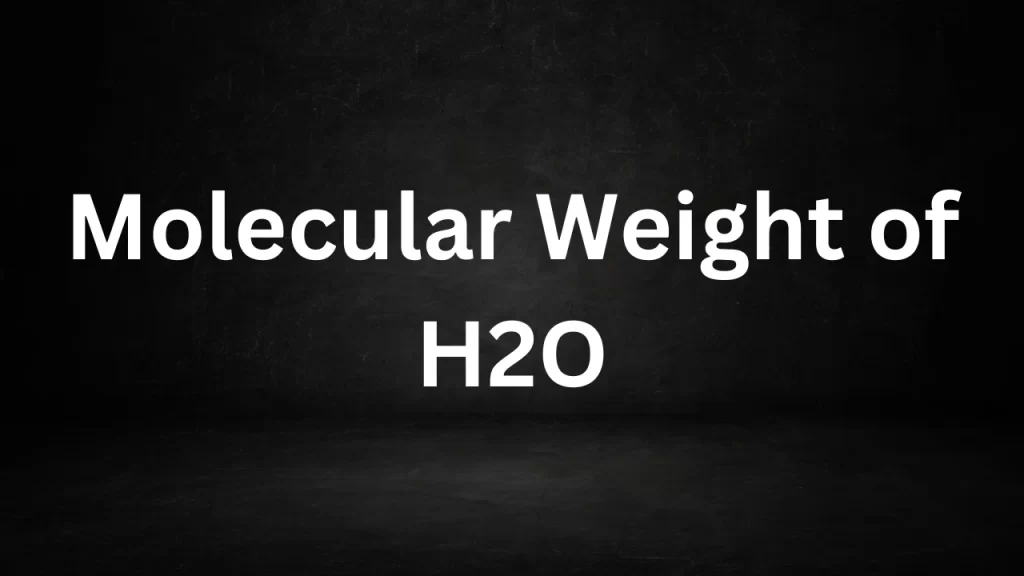Category: Class 9
Molecular Weight Of CaCl2
Molecular Weight Of CaCl2: Calcium chloride, often encountered in various industrial, scientific, and everyday applications, is a compound of significant importance.
Comprehending the molecular weight of calcium chloride (CaCl2) serves as a foundational concept in chemistry and various disciplines. In this article, we will explore the concept of calculating the molecular weight of calcium chloride and its significance across different domains.

Molecular Weight Of CaCl2
The Composition of Calcium Chloride:
Calcium chloride, denoted as CaCl2, constitutes a chemical compound consisting of calcium (Ca) and chlorine (Cl) atoms. This hygroscopic salt finds diverse applications, from de-icing roads during winter to industrial processes and laboratory uses.
Calculating the Molecular Weight of Calcium Chloride:
The molecular weight of a substance, also referred to as molar mass, is the mass of one mole of that substance, typically expressed in grams per mole (g/mol). To determine the molecular weight of calcium chloride (CaCl2), we take into account the atomic masses of its constituent elements: calcium (Ca) and chlorine (Cl).
- The atomic mass of calcium (Ca) is approximately 40.08 g/mol.
- The atomic mass of chlorine (Cl) is approximately 35.45 g/mol.
To find the molecular weight of calcium chloride (CaCl2), we sum the atomic masses of one calcium atom and two chlorine atoms:
Molecular Weight of Calcium Chloride (CaCl2) (g/mol) = (1 × Atomic Mass of Calcium) + (2 × Atomic Mass of Chlorine)
Molecular Weight of Calcium Chloride ≈ (1 × 40.08 g/mol) + (2 × 35.45 g/mol) ≈ 110.98 g/mol
So, the molecular weight of calcium chloride (CaCl2) is approximately 110.98 g/mol.
Significance of Molecular Weight in Chemistry:
- Stoichiometry: Molecular weight plays a pivotal role in stoichiometry, aiding in determining the quantities of reactants and products in chemical reactions.
- Molarity: Within the realm of chemistry, molarity (M) serves as a concentration measure, expressed as moles per liter (mol/L). The calculation of molarity in solutions relies on the molecular weight of the solute.
- Chemical Equations: Molecular weight is essential for balancing chemical equations, ensuring the conservation of mass.
Practical Applications:
- De-Icing and Snow Removal: Calcium chloride finds extensive application in de-icing roads and sidewalks in winter because of its capability to reduce the freezing point of water.
- Dust Control: It is utilized to manage dust on unpaved roads and construction sites.
- Concrete Acceleration: Calcium chloride accelerates the setting of concrete, making it a valuable construction material.
Conclusion:
The molecular weight of calcium chloride (CaCl2), approximately 110.98 g/mol, is a fundamental concept in chemistry with extensive applications in various industries. It is a key factor in stoichiometry, molarity calculations, and chemical equation balancing. Calcium chloride’s versatile uses, influenced by its molecular weight, encompass de-icing, dust control, and concrete acceleration, highlighting the profound impact of chemistry on our daily lives and industrial processes.
Read More
- Molecular Weight Of Copper
- Molecular Mass Of Ethanol
- Molecular Mass of Ammonia
- Molecular Weight of H2O
- Molar Mass Of Sugar
Frequently Asked Questions (FAQs) Molecular Weight Of CaCl2
Q1: What is the molecular weight of calcium chloride (CaCl2)?
A1: The molecular weight of calcium chloride (CaCl2) is approximately 110.98 grams per mole (g/mol). This value is calculated based on the atomic masses of its constituent elements: calcium (Ca) and chlorine (Cl).
Q2: Why is the molecular weight of calcium chloride important in chemistry?
A2: Understanding the molecular weight of calcium chloride is crucial in chemistry because it is used in stoichiometry to determine reactant and product quantities, in molarity calculations for solutions containing calcium chloride, and in balancing chemical equations.
Q3: Can the molecular weight of calcium chloride change under different conditions?
A3: No, the molecular weight of calcium chloride remains constant regardless of temperature, pressure, or other conditions. It is a fixed value based on the atomic masses of calcium and chlorine.
Q4: What are the practical applications of calcium chloride related to its molecular weight?
A4: Calcium chloride has practical applications in de-icing roads, controlling dust on unpaved surfaces, accelerating concrete setting, and as a drying agent in various industries. Its molecular weight is relevant in determining the amount of calcium chloride used in these applications.
Q5: Is calcium chloride safe for use in food and pharmaceuticals?
A5: Calcium chloride is generally recognized as safe (GRAS) when used as a food additive and is used in food preservation, cheese making, and as a firming agent. In pharmaceuticals, it has specific uses and is regulated for safety.
Molecular Weight Of Copper
Molecular Weight Of Copper: Copper, with its distinctive reddish-brown color and remarkable conductivity, is a versatile metal that has been used by humans for thousands of years.
Comprehending the molecular weight of copper (Cu) stands as a cornerstone in the domains of chemistry and materials science. In this article, we will explore the concept of copper’s molecular weight, its calculation, and its significance across diverse fields.

Molecular Weight Of Copper
The Elemental Beauty of Copper:
Copper is one of the few elements that exist in nature in its pure metallic form. Its atomic symbol is Cu, and it belongs to the transition metals group on the periodic table. This metal exhibits excellent electrical conductivity, malleability, and corrosion resistance, making it invaluable for a wide range of applications.
Calculating the Molecular Weight of Copper:
The molecular weight of a substance, commonly known as molar mass, represents the mass of one mole of that substance, expressed in grams per mole (g/mol). When dealing with copper, which exists as individual atoms rather than molecules, calculating its molecular weight is a straightforward process.
The atomic mass of copper (Cu) is approximately 63.55 g/mol.
To find the mole weight of copper (Cu), we simply consider the atomic mass of a single copper atom:
Mole Weight of Copper (Cu) ≈ Atomic Mass of Copper (Cu) ≈ 63.55 g/mol
So, the mole weight of copper is approximately 63.55 g/mol.
Significance of Molecular Weight in Chemistry:
- Stoichiometry: Mole weight is vital in stoichiometry, where it helps determine the quantities of reactants and products in chemical reactions.
- Molarity: In chemistry, molarity (M) is a measure of concentration expressed as moles per liter (mol/L). Molecular weight is used to calculate molarity for solutions containing copper compounds.
- Chemical Reactions: Mole weight plays a pivotal role in balancing chemical equations, ensuring the conservation of mass.
Practical Applications:
- Electrical Wiring: Copper’s high electrical conductivity makes it the material of choice for electrical wiring in homes, buildings, and electronic devices.
- Piping and Tubing: In the realm of plumbing and HVAC systems, copper pipes and tubing find extensive application due to their exceptional resistance to corrosion and high thermal conductivity.
- Coinage: Many coins and medals are made of copper or copper alloys due to the metal’s durability and appealing appearance.
Conclusion:
The mole weight of copper (Cu), approximately 63.55 g/mol, is a foundational concept in chemistry that underpins various calculations and applications. It is especially significant in stoichiometry, molarity calculations, and the balancing of chemical equations. Copper’s remarkable properties, coupled with its molecular weight, have contributed to its enduring role in shaping our modern world, from powering our electronics to ensuring the flow of clean water in our homes. It stands as a testament to the profound impact of chemistry on our daily lives and industrial progress.
Read More
- Molecular Mass Of Ethanol
- Molecular Mass of Ammonia
- Molecular Weight of H2O
- Molar Mass Of Sugar
- Molecular Weight Of Air
Frequently Asked Questions (FAQs) Molecular Weight Of Copper
Q1: What is the molecular weight of copper (Cu)?
A1: The mole weight of copper (Cu) is approximately 63.55 grams per mole (g/mol). This value is based on the atomic mass of a single copper atom.
Q2: Why is knowing the molecular weight of copper important in chemistry?
A2: Understanding the mole weight of copper is essential in chemistry for stoichiometry, molarity calculations, and balancing chemical equations. It helps determine the quantities of copper in reactions and solutions.
Q3: Can the molecular weight of copper change under different conditions?
A3: No, the mole weight of copper remains constant regardless of temperature, pressure, or other conditions. It is a fixed value based on the atomic mass of copper.
Q4: What are the practical applications of copper related to its molecular weight?
A4: Copper’s practical applications are diverse, including electrical wiring, plumbing, coinage, and electronics. Its mole weight is relevant in determining the amount of copper used in various materials and processes.
Q5: Is the molecular weight of copper different when it forms compounds with other elements?
A5: The mole weight of copper may vary when it forms compounds with other elements, as the mole weight of a compound is determined by the combination of atoms within that compound. For example, copper sulfate (CuSO4) has a different mole weight due to the inclusion of sulfur and oxygen atoms.
Molecular Mass Of Ethanol
Molecular Mass Of Ethanol: Ethanol, known for its widespread use as an alcohol in beverages and as a fuel additive, holds a central position in the realms of chemistry and industry.
Understanding the mole mass of ethanol (C2H5OH) is fundamental in comprehending its properties and applications. In this article, we will explore the concept of the molecular mass of ethanol, its calculation, and its significance in various fields.
Molecular Mass Of Ethanol
The Chemical Composition of Ethanol:
Ethanol, commonly known as alcohol, is a chemical compound comprising carbon (C), hydrogen (H), and oxygen (O) atoms. Its mole formula is C2H5OH, which signifies that each ethanol molecule consists of two carbon atoms, six hydrogen atoms, and one oxygen atom.
Calculating the Molecular Mass of Ethanol:
The molecular mass of a substance is its mass when considering one mole of that substance, expressed in grams per mole (g/mol). To calculate the molecular mass of ethanol, we consider the atomic masses of its constituent elements, carbon (C), hydrogen (H), and oxygen (O).
- The atomic mass of carbon (C) is approximately 12.01 g/mol.
- The atomic mass of hydrogen (H) is approximately 1.01 g/mol.
- The atomic mass of oxygen (O) is approximately 16.00 g/mol.
To find the mole mass of ethanol (C2H5OH), we sum the atomic masses of its constituent atoms:
Mole Mass of Ethanol (C2H5OH) (g/mol) = (2 × Atomic Mass of Carbon) + (6 × Atomic Mass of Hydrogen) + (1 × Atomic Mass of Oxygen)
Mole Mass of Ethanol ≈ (2 × 12.01 g/mol) + (6 × 1.01 g/mol) + (1 × 16.00 g/mol) ≈ 46.07 g/mol
So, the mole mass of ethanol (C2H5OH) is approximately 46.07 g/mol.
Significance of Molecular Mass in Chemistry:
- Stoichiometry: Mole mass is crucial in stoichiometry, facilitating the determination of reactant and product quantities in chemical reactions.
- Molarity (M): in chemistry is a concentration measure expressed as moles per liter (mol/L). Molar mass is crucial in molarity calculations for solutions.
- Chemical Equations: Mole mass plays a pivotal role in balancing chemical equations, ensuring the conservation of mass.
Practical Applications:
- Beverage Industry: Ethanol is a key component in alcoholic beverages, and understanding its molecular mass is essential for quality control and labeling.
- Fuel Production: Ethanol is used as a biofuel additive, and its properties, influenced by molecular mass, affect combustion and engine performance.
- Pharmaceuticals: Ethanol is used in the pharmaceutical industry, where its molecular mass plays a role in drug formulations and dosage calculations.
Conclusion:
The mole mass of ethanol (C2H5OH), approximately 46.07 g/mol, is a fundamental concept in chemistry with extensive applications in numerous industries. It is a cornerstone in stoichiometry, molarity calculations, and chemical equation balancing. Whether in the production of alcoholic beverages, as a biofuel, or in pharmaceutical formulations, understanding the mole mass of ethanol is vital for precision and efficiency in various processes. It underscores the pivotal role of chemistry in both everyday life and industrial applications.
Read More
- Molecular Mass of Ammonia
- Molecular Weight of H2O
- Molar Mass Of Sugar
- Molecular Weight Of Air
- Molar Mass Of Ag
Frequently Asked Questions (FAQs) Molecular Mass Of Ethanol
Q1: What is the molecular mass of ethanol (C2H5OH)?
A1: The mole mass of ethanol, often represented as C2H5OH, is approximately 46.07 grams per mole (g/mol). To calculate this value, you add the atomic masses of its constituent elements: carbon (C), hydrogen (H), and oxygen (O).
Q2: Why is knowing the molecular mass of ethanol important in chemistry?
A2: Understanding the mole mass of ethanol is essential in chemistry because it aids in stoichiometry calculations, determining concentrations (molarity) in solutions, and balancing chemical equations.
Q3: What practical applications are related to ethanol’s molecular mass?
A3: Ethanol has various practical applications, including its use in alcoholic beverages, as a biofuel additive, and in pharmaceutical formulations. Its molecular mass influences its properties and applications in these industries.
Q4: Does the molecular mass of ethanol change with temperature or pressure?
A4: The mole mass of ethanol (C2H5OH) remains constant regardless of temperature or pressure. It is a fixed value based on the atomic masses of carbon, hydrogen, and oxygen.
Q5: Is ethanol the same as ethyl alcohol?
A5: Yes, ethanol is often referred to as ethyl alcohol. It is the same chemical compound and is used interchangeably in various contexts, including in beverages and industrial applications.
Molecular Mass of Ammonia
Molecular Mass of Ammonia: Ammonia, with its pungent odor and versatile applications, is a compound that holds significant importance in both chemistry and various industries.
Understanding the mole mass of ammonia (NH3) is fundamental in comprehending its properties and applications. In this article, we will delve into the concept of the molecular mass of ammonia, its calculation, and its relevance in different fields.

Molecular Mass of Ammonia
The Chemical Composition of Ammonia:
Ammonia, represented as NH3, is a compound composed of nitrogen (N) and hydrogen (H) atoms. It is a colorless gas at room temperature and has a characteristic, strong odor. The ammonia molecule consists of one nitrogen atom bonded to three hydrogen atoms.
Calculating the Molecular Mass of Ammonia:
The mole mass of a substance is defined as the mass of one mole of that substance, expressed in grams per mole (g/mol). To calculate the molecular mass of ammonia, we consider the atomic masses of its constituent elements, nitrogen (N) and hydrogen (H).
- The atomic mass of nitrogen (N) is approximately 14.01 g/mol.
- The atomic mass of hydrogen (H) is approximately 1.01 g/mol.
To find the mole mass of ammonia (NH3), we sum the atomic masses of one nitrogen atom and three hydrogen atoms:
Mole Mass of Ammonia (NH3) (g/mol) = (1 × Atomic Mass of Nitrogen) + (3 × Atomic Mass of Hydrogen)
Molecular Mass of Ammonia ≈ (1 × 14.01 g/mol) + (3 × 1.01 g/mol) ≈ 17.04 g/mol
So, the mole mass of ammonia (NH3) is approximately 17.04 g/mol.
Significance of Molecular Mass in Chemistry:
Stoichiometry: Mole mass plays a crucial role in stoichiometry, aiding in determining the quantities of reactants and products in chemical reactions.
- Molarity: In chemistry, molarity (M) is a measure of concentration expressed as moles per liter (mol/L). Mole mass is used to calculate molarity in solutions.
- Chemical Equations: Mole mass is vital for balancing chemical equations and ensuring the conservation of mass.
Practical Applications:
Fertilizer Production: Ammonia is a key component in fertilizer production, and understanding its mole mass is important for precise formulation.
- Cooling and Refrigeration: Ammonia is used as a refrigerant in various cooling systems, where its properties are influenced by its molecular mass.
- Household Cleaning: Ammonia-based cleaning products rely on the properties of ammonia, including its mole mass.
Conclusion:
The mole mass of ammonia (NH3), approximately 17.04 g/mol, is a fundamental concept in chemistry with wide-ranging applications in various industries. It plays a pivotal role in stoichiometry, molarity calculations, and balancing chemical equations. Whether in the laboratory, agriculture, or refrigeration, understanding the mole mass of ammonia is essential for precision and efficiency in a multitude of processes. It underscores the significance of chemistry in everyday life and industrial processes.
Read More
- Molecular Weight of H2O
- Molar Mass Of Sugar
- Molecular Weight Of Air
- Molar Mass Of Ag
- Molar Mass Of K
Frequently Asked Questions (FAQs) On Molecular Mass of Ammonia
Q1: What is the molecular mass of ammonia (NH3)?
A1: The mole mass of ammonia (NH3) is approximately 17.04 grams per mole (g/mol). To determine this value, you add the atomic masses of one nitrogen atom (N) and three hydrogen atoms (H) within a single ammonia molecule.
Q2: Why is knowing the molecular mass of ammonia important in chemistry?
A2: Understanding the mole mass of ammonia is crucial in chemistry because it enables precise calculations in stoichiometry, helps in determining concentrations (molarity) in solutions, and plays a fundamental role in balancing chemical equations.
Q3: What practical applications are there for ammonia that relate to its molecular mass?
A3: Ammonia has various practical applications, such as in fertilizer production, cooling and refrigeration systems, and household cleaning products. Its molecular mass influences its properties in these applications.
Q4: Does the molecular mass of ammonia change with temperature or pressure?
A4: The mole mass of ammonia (NH3) remains constant regardless of temperature or pressure. It is a fixed value based on the atomic masses of nitrogen and hydrogen.
Q5: Is ammonia a gas at room temperature?
A5: Yes, ammonia (NH3) is a colorless gas at room temperature, characterized by its pungent odor. It has a boiling point of -33.34 degrees Celsius (-28.012 degrees Fahrenheit) under standard atmospheric pressure.
Molecular Weight of H2O
Molecular Weight of H2O: Water, Earth’s most abundant and vital substance, consists of molecules possessing a distinct molecular weight critical for all life forms.
Understanding the molecular weight of water, represented as H2O, is fundamental not only in chemistry but also in various scientific and practical applications.
This article delves into the concept of H2O’s molecular weight, its calculation, and its importance across various fields of science and industry.

Molecular Weight of H2O
The Composition of Water:
Water, with the chemical formula H2O, consists of two hydrogen atoms (H) covalently bonded to a single oxygen atom (O). These atoms come together to form a water molecule. This molecular arrangement gives water its unique properties, such as its ability to dissolve a wide range of substances and its high heat capacity.
Calculating the Molecular Weight of H2O:
The molecular weight of a substance is defined as the mass of one mole of that substance, expressed in grams per mole (g/mol). To calculate the molecular weight of H2O, we consider the atomic masses of its constituent elements, hydrogen (H) and oxygen (O).
- The atomic mass of hydrogen (H) is approximately 1.01 g/mol.
- The atomic mass of oxygen (O) is approximately 16.00 g/mol.
To find the mole weight of H2O, we add the atomic masses of two hydrogen atoms and one oxygen atom:
Mole Weight of H2O (g/mol) = (2 × Atomic Mass of Hydrogen) + (1 × Atomic Mass of Oxygen)
Mole Weight of H2O ≈ (2 × 1.01 g/mol) + (1 × 16.00 g/mol) ≈ 18.02 g/mol
So, the mole weight of H2O (water) is approximately 18.02 g/mol.
Significance of Molecular Weight in Chemistry:
- Stoichiometry: Mole weight is crucial in stoichiometry, which involves determining the quantities of reactants and products in chemical reactions.
- Molarity: In chemistry, molarity (M) is a measure of the concentration of a substance in a solution. Molecular weight serves as a key factor in calculating molarity, a measure expressed as moles per liter (mol/L).
- Chemical Equations: Mole weight plays a vital role in balancing chemical equations to ensure the conservation of mass.
Real-World Applications:
- Laboratory Work: Chemists and researchers use the molecular weight of substances like water in laboratory experiments and analyses.
- Pharmaceuticals: Molecular weight is critical in pharmaceuticals for dosage calculations and drug formulation.
- Environmental Science: Understanding the molecular weight of water is essential in environmental science for assessing water quality and pollutant concentrations.
Conclusion:
The mole weight of H2O, approximately 18.02 g/mol, is a fundamental concept in chemistry and has broad applications in various scientific and practical fields. Whether in the laboratory, pharmaceutical industry, or environmental science, knowing the molecular weight of water is essential for precise measurements and calculations. It is a reminder of the simple yet profound principles that govern the behavior of substances at the molecular level, shaping our understanding of the world around us.
Read More
- Molecular Weight Of K2Cr2O7
- Molecular Weight Of Phosphorus
- Molecular Weight Of SO2
- Molecular Weight of Na2CO3
- Molecular Mass Of Sodium
Frequently Asked Questions (FAQs) on Molecular Weight of H2O
Q1: What is the molecular weight of H2O (water)?
A1: The mole weight of H2O, which is water, is approximately 18.02 grams per mole (g/mol). This value is calculated by summing the atomic masses of two hydrogen atoms (H) and one oxygen atom (O) in a water molecule.
Q2: Why is knowing the molecular weight of H2O important?
A2: Understanding the mole weight of H2O is crucial in various scientific and practical applications. It is used in chemistry for stoichiometry, molarity calculations, and balancing chemical equations. In fields like environmental science and pharmaceuticals, it helps in precise measurements and dosage calculations.
Q3: Does the molecular weight of H2O change with temperature or pressure?
A3: The molecular weight of H2O remains constant regardless of temperature or pressure. It is a fixed value based on the atomic masses of hydrogen and oxygen.
Q4: How is the molecular weight of H2O calculated?
A4: The mole weight of H2O is calculated by adding the atomic masses of its constituent elements. The atomic mass of hydrogen (H) is approximately 1.01 g/mol, and the atomic mass of oxygen (O) is approximately 16.00 g/mol. Therefore, for water (H2O), it is approximately 18.02 g/mol.
Q5: Can the molecular weight of H2O vary in different types of water?
A5: The mole weight of H2O is the same for all types of water, including distilled water, tap water, and seawater. It is a constant value based on the chemical composition of water, which consists of two hydrogen atoms and one oxygen atom per molecule.
Molar Mass Of Sugar
Molar Mass Of Sugar: Sugar, a ubiquitous and beloved substance in our daily lives, plays a significant role in both the culinary world and the field of chemistry.
While we often think of sugar solely in terms of its sweetening properties, it also holds importance in the realm of chemistry due to its molar mass. In this article, we will explore the concept of the molar mass of sugar, its chemical composition, and its practical applications.

Molar Mass Of Sugar
The Chemical Composition of Sugar:
Sugar, commonly referred to as sucrose, is a carbohydrate. Chemically, it is composed of carbon (C), hydrogen (H), and oxygen (O) atoms. The molecular formula of sucrose is C12H22O11. This formula tells us that each molecule of sucrose consists of 12 carbon atoms, 22 hydrogen atoms, and 11 oxygen atoms.
Determining the Molar Mass of Sugar:
The molar mass of a substance is its mass in grams per mole (g/mol), representing one mole of that substance. To calculate the mol mass of sugar (sucrose), we need to consider the atomic masses of its constituent elements. Here are the atomic masses of the elements in sucrose:
- – Carbon (C) has an atomic mass of approximately 12.01 g/mol.
- – Hydrogen (H) has an atomic mass of approximately 1.01 g/mol.
- – Oxygen (O) has an atomic mass of approximately 16.00 g/mol.
To find the mol mass of sugar, we sum the atomic masses of all the atoms in one mole of sucrose:
Mol Mass of Sugar (C12H22O11) = (12 × Atomic Mass of Carbon) + (22 × Atomic Mass of Hydrogen) + (11 × Atomic Mass of Oxygen)
Mol Mass of Sugar ≈ (12 × 12.01 g/mol) + (22 × 1.01 g/mol) + (11 × 16.00 g/mol) ≈ 342.34 g/mol
So, the mol mass of sugar (sucrose) is approximately 342.34 g/mol.
Significance of Molar Mass in Chemistry:
1. Stoichiometry: Molar mass is essential for stoichiometry, as it helps determine the quantity of reactants and products in chemical reactions.
2. Empirical and Molecular Formulas: Molar mass is used to find the empirical and molecular formulas of compounds, helping chemists understand their structures.
3. Concentration Calculations: In solutions, molar mass is vital for calculating concentrations, such as molarity (moles per liter), which is commonly used in chemistry labs.
4. Chemical Reactions: Molar mass plays a critical role in balancing chemical equations and ensuring the conservation of mass.
Conclusion:
The mol mass of sugar (sucrose), approximately 342.34 g/mol, is a fundamental concept in chemistry. Understanding the mol mass of compounds like sugar is crucial for various chemical calculations and has practical applications in fields ranging from cooking to pharmaceuticals. While sugar may continue to satisfy our sweet cravings, its chemical composition and molar mass continue to be of interest and significance in the world of science.
Read More
- Molecular Weight Of Air
- Molar Mass Of Ag
- Molar Mass Of K
- Molar Mass Of Magnesium
- Law Of Conservation Of Energy
Frequently Asked Questions (FAQs) Molar Mass Of Sugar
Q1: What is the molar mass of sugar?
A1: The mol mass of sugar, specifically sucrose (C12H22O11), is approximately 342.34 grams per mole (g/mol).
Q2: Why is the molar mass of sugar important in chemistry?
A2: The mol mass of sugar is crucial in chemistry because it allows us to determine the quantity of sugar in chemical reactions, calculate concentrations of sugar solutions, and find the empirical and molecular formulas of sugar compounds.
Q3: How is the molar mass of sugar calculated?
A3: To calculate the mol mass of sugar, you sum the atomic masses of all the atoms in one mole of sucrose (C12H22O11). This involves considering the atomic masses of carbon (C), hydrogen (H), and oxygen (O) in the compound.
Q4: Can the molar mass of sugar be used to measure the sweetness of sugar?
A4: No, the mol mass of sugar does not directly measure its sweetness. Sweetness is a sensory perception, while mol mass is a measure of the mass of sugar molecules per mole. The sweetness of sugar depends on various factors, including taste receptors in our mouths.
Q5: Is the molar mass of sugar the same for all types of sugar, like table sugar and brown sugar?
A5: The mol mass of sugar (sucrose) is the same regardless of the source. Whether it’s table sugar, brown sugar, or other sugar types, sucrose has the same chemical composition and molar mass. However, different sugars may contain impurities or water, which can affect their overall mass but not their molar mass.
Molecular Weight Of Air
Molecular Weight Of Air: Air, the invisible mixture of gases that surrounds our planet, plays a vital role in sustaining life. While it may seem weightless, it does indeed have a molecular weight. In this article, we will explore the concept of the mole weight of air, its composition, and its significance in various scientific and practical applications.

Molecular Weight Of Air
Composition of Air:
The predominant components of air are the two major gases: nitrogen (N2) and oxygen (O2). These two gases make up the majority of the Earth’s atmosphere, accounting for approximately 99% of the total volume. Other gases, such as carbon dioxide (CO2), argon (Ar), neon (Ne), helium (He), and traces of other elements and compounds, make up the remaining 1%.
Calculating the Molecular Weight of Air:
To calculate the mole weight of air, we must consider the molecular weights of its constituent gases and their relative abundances. Here are the key steps to determine the mole weight of air:
- Identify the Constituent Gases: As mentioned earlier, nitrogen (N2) and oxygen (O2) are the two most abundant gases in the atmosphere. Their molecular weights are approximately 28 g/mol (for N2) and 32 g/mol (for O2).
- Determine the Relative Abundances: The Earth’s atmosphere consists of approximately 78% nitrogen (N2) and 21% oxygen (O2). The remaining gases make up the remaining 1%.
- Calculate the Weighted Average: To find air’s molecular weight, calculate a weighted average using the molecular weights and relative gas abundances.
Using this formula:
mole Weight of Air (g/mol) = (Abundance of N2 × mole Weight of N2) + (Abundance of O2 × mole Weight of O2) + …
mole Weight of Air (g/mol) = (0.78 × 28 g/mol) + (0.21 × 32 g/mol) + …
The calculated mole weight of air is approximately 28.97 g/mol.
Significance of Molecular Weight of Air:
- Avogadro’s Law: The mole weight of air is crucial for understanding Avogadro’s law, which states that equal volumes of gases, at the same temperature and pressure, contain an equal number of molecules. This principle is essential in the study of gases.
- Gas Laws: Knowledge of the mole weight of air is essential in various gas laws, such as the ideal gas law (PV = nRT), where it helps in calculating the properties of gases under different conditions.
- Atmospheric Science: Understanding the mole weight of air is vital in atmospheric science, including weather forecasting and the study of air pollutants.
- Aeronautics and Aviation: In aviation, engineers and pilots use air’s molecular weight to evaluate aircraft performance, including lift and thrust.
Conclusion:
The mole weight of air, approximately 28.97 g/mol, provides a foundational understanding of the Earth’s atmosphere. It is a critical factor in various scientific fields, including chemistry, physics, atmospheric science, and engineering. Comprehending air’s composition and properties aids in grasping natural phenomena and advancing technologies dependent on gas behavior in our environment.
Read More
- Molecular Weight Of K2Cr2O7
- Molecular Weight Of Phosphorus
- Molecular Weight Of SO2
- Molecular Weight of Na2CO3
- Molecular Mass Of Sodium
Frequently Asked Questions (FAQs) Molecular Weight Of Air
Q1: What is the molecular weight of air?
A1: The mole weight of air is approximately 28.97 grams per mole (g/mol). This value is calculated based on the molecular weights and relative abundances of its constituent gases, primarily nitrogen (N2) and oxygen (O2).
Q2: Why is it important to know the molecular weight of air?
A2: Understanding the mole weight of air is important in various scientific fields and practical applications. It helps in gas law calculations, atmospheric science, aeronautics, and aviation, among others. It also serves as a fundamental concept in the study of gases.
Q3: How is the molecular weight of air calculated?
A3: The mole weight of air is calculated by considering the mole weights of its constituent gases (e.g., nitrogen and oxygen) and their relative abundances in the atmosphere. It involves a weighted average calculation based on these factors.
Q4: Does the molecular weight of air change with altitude or location?
A4: The mole weight of air remains relatively constant at different altitudes and locations on Earth. However, variations in the composition of air, such as changes in the concentration of water vapor or pollutants, can cause minor fluctuations in the molecular weight of air.
Q5: How is the molecular weight of air used in aviation and aeronautics?
A5: In aviation and aeronautics, the mole weight of air is used to determine aircraft performance, including lift, thrust, and engine efficiency. It plays a crucial role in calculations related to aircraft design and operation.
Molar Mass Of Ag
Molar Mass Of Ag: In the realm of chemistry, the concept of molar mass is fundamental. It is a crucial parameter that helps chemists determine the quantity of a substance in a given sample, balance chemical equations, and predict reaction outcomes.
In this article, we will delve into the molar mass of silver (Ag) and explore its significance in the world of chemistry.

Molar Mass Of Ag
Silver (Ag) – A Brief Overview:
Silver is a chemical element with the symbol Ag and atomic number 47. It is a lustrous, white metal known for its excellent electrical conductivity, ductility, and malleability. Silver boasts a millennia-old legacy, serving diverse roles such as currency, adornment, and photographic material throughout history.
Determining the Molar Mass of Silver:
The molar mass of an element is defined as the mass of one mole of that element, expressed in grams per mole (g/mol). To calculate the molar mass of silver (Ag), we need to consider its atomic mass, which can be found on the periodic table. The atomic mass of silver is approximately 107.87 atomic mass units (amu).
In chemical calculations, the atomic mass is converted to grams per mole (g/mol), resulting in silver’s (Ag) molar mass of approximately 107.87 g/mol.
Significance of Molar Mass in Chemistry:
- Stoichiometry: Molar mass is essential in stoichiometry, which deals with the quantitative relationships between reactants and products in chemical reactions. It helps in determining the amount of substances involved in a reaction.
- Empirical and Molecular Formulas: Molar mass is used to find the empirical and molecular formulas of compounds. By comparing the molar mass of a compound with its elemental composition, chemists can deduce the ratios of atoms and determine its formula.
- Concentration Calculations: Molar mass is crucial for calculating concentrations of solutions. For example, it finds application in determining the molarity (M) of a solution, which represents moles of solute per liter of solution.
- Gas Laws: In gas law calculations, including the ideal gas law (PV = nRT), molar mass is essential for connecting gas mass, moles, and volume.
- Chemical Reactions: Molar mass is pivotal for balancing chemical equations, maintaining the law of mass conservation.
Applications of Silver (Ag) in Chemistry:
Silver has various applications in chemistry, including:
- Photography: Silver compounds in traditional photography undergo chemical reactions to create images.
- Electronics: Silver’s conductivity makes it valuable in electronic components, including conductive pastes and circuit boards.
- Medicine: Silver compounds are antimicrobial, finding use in medical applications such as wound dressings and surgical instruments.
Conclusion:
Silver’s (Ag) molar mass is a foundational concept in chemistry, indispensable for numerous chemical calculations and practical applications. Comprehending the molar mass of elements, such as silver, is vital for precise chemical analysis and advancing products and technologies.
Read More
- Molar Mass Of K
- Molar Mass Of Magnesium
- Law Of Conservation Of Energy
- Difference Between Equinox And Solstice
- Molecular Weight Of K2Cr2O7
Frequently Asked Questions (FAQs) On Molar Mass Of Ag
Q1: What is the molar mass of silver (Ag)?
A1: The molar mass of silver (Ag) is approximately 107.87 grams per mole (g/mol).
Q2: Why is the molar mass of silver important in chemistry?
A2: Silver’s molar mass is pivotal in chemistry for determining silver quantities in reactions, solution concentrations, and deriving silver compound formulas.
Q3: How is the molar mass of silver calculated?
A3: Calculate silver’s molar mass by summing the atomic masses of all atoms in a mole of silver (Ag). The atomic mass of silver, approximately 107.87 atomic mass units (amu), is readily available on the periodic table.
Q4: What is the significance of molar mass in stoichiometry?
A4: Molar mass is essential in stoichiometry, as it helps determine the quantity of substances involved in chemical reactions. It allows chemists to balance chemical equations and predict reaction outcomes accurately.
Q5: Are there any practical applications of silver (Ag) in chemistry beyond its molar mass?
A5: Yes, silver has various applications in chemistry, including its use in traditional photography, electronics due to its excellent conductivity, and medicine for its antimicrobial properties in wound dressings and medical instruments.
Molar Mass Of Potassium (K)
Molar Mass Of K: In the world of chemistry, one of the fundamental concepts is the molar mass of an element. It is essential in diverse chemical computations, encompassing substance quantification in samples and forecasting reaction results.
This article delves into potassium’s (K) molar mass, examining its importance within the realm of chemistry and its various applications.

Molar Mass Of K
Potassium (K) – A Brief Overview:
Potassium, symbolized as K with atomic number 19, is classified within the alkali metal group on the periodic table. This element holds significant importance as an essential nutrient vital for the well-being of all living organisms, including humans. Potassium ions (K+) play a pivotal role in various physiological processes, such as nerve signal transmission, muscle contractions, and cellular functionality, making them indispensable in the realm of biology.
Determining the Molar Mass of Potassium:
The molar mass of an element is the mass of one mole of that element, in grams per mole (g/mol). To calculate potassium’s molar mass, we use its atomic mass, found on the periodic table, approximately 39.10 atomic mass units (amu).
However, in chemical calculations, we usually consider the molar mass of potassium as 39.10 g/mol. This is because the atomic mass unit (amu) is a very small unit of measurement, and it is more convenient to work with grams per mole in laboratory settings and chemical equations.
The molar mass of potassium (K) is, therefore, 39.10 g/mol.
Significance of Molar Mass in Chemistry:
- Stoichiometry: Molar mass is crucial in stoichiometry, the branch of chemistry that deals with the quantitative relationships between reactants and products in chemical reactions. It helps in determining the amount of reactants needed or products formed during a chemical reaction.
- Empirical and Molecular Formulas: Molar mass aids in deducing the empirical and molecular formulas of compounds by comparing it with elemental composition. This reveals atom ratios and compound formulas.
- Concentration Calculations: In solutions and mixtures, molar mass is essential for calculating concentrations. For example, it is employed in calculating the molarity (M) of a solution, defined as the moles of solute per liter of solution.
- Gas Laws: Molar mass is crucial in gas law calculations, such as the ideal gas law (PV = nRT). It helps convert between mass, moles, and volume when dealing with gases.
- Chemical Reactions: Molar mass is instrumental in achieving balance in chemical equations, ensuring compliance with the law of conservation of mass.
Applications of Potassium (K) in Chemistry:
Aside from its importance in understanding molar mass, potassium itself has various applications in chemistry. Some notable examples include:
- Potassium Hydroxide (KOH): Used in the manufacture of soap and as a strong base in chemical processes.
- Potassium Nitrate (KNO3): Used in fireworks, fertilizers, and as a food preservative.
- Potassium Permanganate (KMnO4): A powerful oxidizing agent used in various chemical reactions and water treatment.
Conclusion:
Potassium’s (K) molar mass is a foundational concept in chemistry, with a pivotal role in multiple aspects of the field. Understanding the molar mass of elements is essential for accurate chemical calculations, stoichiometry, and the study of chemical reactions. Potassium’s molar mass, 39.10 g/mol, is significant not just in chemistry but also vital as a nutrient for all living organisms.
Read More
- Molar Mass Of Magnesium
- Law Of Conservation Of Energy
- Difference Between Equinox And Solstice
- Molecular Weight Of K2Cr2O7
- Molecular Weight Of Phosphorus
Frequently Asked Questions (FAQs) On Molar Mass Of K
Q1: What is molar mass?
A1: Molar mass, measured in grams per mole (g/mol), represents the mass of a single mole of a substance. This foundational concept in chemistry plays a pivotal role in various calculations, encompassing stoichiometry and the determination of substance quantities within samples.
Q2: What is the molar mass of potassium (K)?
A2: The molar mass of potassium (K) is approximately 39.10 grams per mole (g/mol). This value is commonly used in chemical calculations and is found on the periodic table.
Q3: Why is molar mass important in chemistry?
A3: Molar mass is important in chemistry because it allows chemists to relate the mass of a substance to the number of moles of that substance. It is essential for stoichiometry, determining chemical formulas, calculating concentrations, and balancing chemical equations.
Q4: How is the molar mass of an element determined?
A4: The molar mass of an element is calculated by adding up the atomic masses of all the atoms in one mole of that element. This information is typically found on the periodic table and is expressed in atomic mass units (amu). To apply it in chemical computations, the atomic mass is converted to grams per mole (g/mol).
Q5: Is the molar mass of potassium used only in chemistry?
A5: Although potassium’s molar mass is predominantly utilized in chemistry, potassium has diverse applications beyond the field. For instance, potassium compounds are integral to fireworks, fertilizers, and soap production.
Molar Mass Of Magnesium
Molar Mass Of Magnesium: Magnesium, a versatile and essential element, holds a significant place in the periodic table.
Its role in various natural processes, industrial applications, and biological systems makes it a subject of great interest in the world of chemistry. In this article, we’ll explore the concept of the molar mass of magnesium, understand its significance, and uncover the atomic weight of this mighty element.

Molar Mass Of Magnesium
Understanding Molar Mass
Before we delve into the specifics of magnesium, let’s establish what molar mass signifies. Molar mass, often referred to as molecular weight or atomic weight, is a fundamental concept in chemistry. It represents the mass of a substance in grams per mole (g/mol) and is expressed in unified atomic mass units (u) or atomic mass units (amu).
The molar mass is calculated by summing the atomic masses of all the atoms in a chemical compound, considering their respective proportions. It serves as a bridge between the microscopic world of atoms and molecules and the macroscopic world of measurable quantities in chemistry.
The Atomic Structure of Magnesium
Magnesium, with the atomic symbol Mg and atomic number 12, is a light, silvery-white, and highly abundant element in the Earth’s crust. It falls within Group 2 (Group IIA) on the periodic table, a category recognized as the alkaline earth metals. Magnesium’s atomic configuration exhibits the following features:
Atomic Number: 12 (indicating the number of protons in the nucleus)
- Atomic Mass: Approximately 24.31 atomic mass units (u)
- Electron Configuration: [Ne] 3s² (indicating its electron arrangement)
- Number of Electrons: 12 (equal to the number of protons in a neutral atom)
Calculating the Molar Mass of Magnesium
The mol mass of magnesium is determined by summing the atomic mass of a single magnesium atom. Since magnesium exists as individual atoms in its elemental form (Mg), the mol mass is equal to its atomic mass. The atomic mass of magnesium is approximately 24.31 u.
Therefore, the mol mass of magnesium (Mg) is approximately 24.31 g/mol. This numerical value finds application in diverse chemical calculations, including the determination of magnesium quantities in a given sample and assessing the composition of chemical compounds containing magnesium atoms.
Significance of the Molar Mass of Magnesium
The mol mass of magnesium is of great importance in several domains:
1. Chemical Reactions: In stoichiometry, the molar mass plays a vital role in determining the quantities of reactants and products involved in chemical reactions. It enables chemists to balance chemical equations and calculate the mass of substances consumed or produced.
2. Laboratory Analysis: When conducting experiments involving magnesium, scientists and researchers need to know its molar mass to make precise measurements and ensure accurate results.
3. Industrial Applications: Industries that utilize magnesium and its compounds, such as the automotive and aerospace sectors, rely on the molar mass for quality control and product development.
4. Environmental Studies: Environmental scientists use the molar mass of magnesium to analyze soil composition, study groundwater chemistry, and assess the impact of magnesium-containing substances on ecosystems.
5. Dietary Considerations: Magnesium is an essential mineral in the human diet, and its molar mass is relevant for nutritional assessments and dietary recommendations.
Conclusion: Magnesium’s Atomic Weight Unveiled
In conclusion, the molar mass of magnesium, approximately 24.31 g/mol, is a fundamental parameter in chemistry. It represents the atomic weight of this versatile element, empowering scientists, researchers, and industries to explore its diverse applications. Beyond the lab, magnesium’s importance extends to advancing science, technology, and enhancing our comprehension of the natural world.
Read More
- Law Of Conservation Of Energy
- Difference Between Equinox And Solstice
- Molecular Weight Of K2Cr2O7
- Molecular Weight Of Phosphorus
- Molecular Weight Of SO2
Frequently Asked Questions (FAQs) Molar Mass Of Magnesium
1. What is the molar mass of magnesium?
The mol mass of magnesium (Mg) is approximately 24.31 grams per mole (g/mol).
2. How is the mol mass of magnesium calculated?
The mol mass of magnesium is calculated by summing the atomic mass of a single magnesium atom. In the case of magnesium, the atomic mass is approximately 24.31 atomic mass units (u), which is equivalent to 24.31 g/mol.
3. Why is the mol mass of magnesium important in chemistry?
Magnesium’s molar mass is vital for chemical calculations like stoichiometry, aiding in balancing equations and precisely measuring reactants and products.
4. Is the mol mass of magnesium used in industries and manufacturing processes?
Yes, industries that utilize magnesium or magnesium-containing compounds rely on the mol mass for quality control, product development, and ensuring the proper composition of materials.
5. How does the mol mass of magnesium impact environmental studies?
Environmental scientists use the mol mass of magnesium to analyze soil composition, assess groundwater chemistry, and study the environmental impact of magnesium-containing substances.
